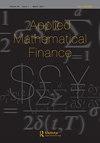Spiking the Volatility Punch
Q3 Mathematics
引用次数: 0
Abstract
ABSTRACT An alternative volatility index called SPIKES has been recently introduced. Like VIX, SPIKES aims to forecast S&P 500 volatility over a 30-day horizon and both indexes are based on the same theoretical formula; yet, they differ in several ways. While some differences are introduced in response to the controversy surrounding possible VIX manipulation, others are due to the choice of the S&P500 exchange-traded fund (ETF), named SPY, as a substitute for the S&P500 (SPX) Index itself. Indeed, options on the SPX, used for VIX computation, are European-style, whereas options on the SPY ETF, used for SPIKES computation, are American-style. Overall, the difference is mainly due to the early exercise premium of the component options and the dividend timing of the underlying SPY versus SPX and we assess the magnitude of these separate contributions under the benchmark Black, Merton and Scholes setting. By applying both the finite difference method and newly-derived approximation formulas we show that the new SPIKES index will track the VIX index as long as 30-day US interest rates and annualized dividend yields continue to be range-bound between 0 and 10% per year. Hence, after more that 20 years of supremacy, VIX may have found its first competitor.加剧波动性冲击
最近引入了一种名为SPIKES的替代波动率指数。与VIX一样,SPIKES旨在预测标准普尔500指数在30天内的波动率,这两个指数都基于相同的理论公式;然而,它们在几个方面有所不同。虽然引入一些差异是为了应对围绕可能操纵波动率的争议,但其他差异是由于选择了名为SPY的标准普尔500交易所交易基金(ETF)作为标准普尔500指数(SPX)本身的替代品。实际上,用于VIX计算的SPX期权是欧式的,而用于SPIKES计算的SPY ETF期权是美式的。总体而言,差异主要是由于组件期权的早期行权溢价和基础SPY相对于SPX的股息时间,我们在基准Black, Merton和Scholes设置下评估这些单独贡献的大小。通过应用有限差分法和新导出的近似公式,我们表明,只要美国30天的利率和年化股息收益率继续在每年0到10%之间波动,新的SPIKES指数就会跟踪VIX指数。因此,在称霸20多年后,VIX指数可能找到了第一个竞争对手。
本文章由计算机程序翻译,如有差异,请以英文原文为准。
求助全文
约1分钟内获得全文
求助全文
来源期刊

Applied Mathematical Finance
Economics, Econometrics and Finance-Finance
CiteScore
2.30
自引率
0.00%
发文量
6
期刊介绍:
The journal encourages the confident use of applied mathematics and mathematical modelling in finance. The journal publishes papers on the following: •modelling of financial and economic primitives (interest rates, asset prices etc); •modelling market behaviour; •modelling market imperfections; •pricing of financial derivative securities; •hedging strategies; •numerical methods; •financial engineering.
 求助内容:
求助内容: 应助结果提醒方式:
应助结果提醒方式:


